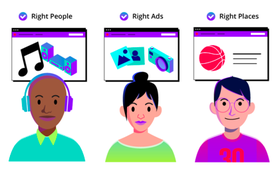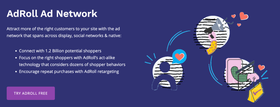Why AdRoll is Your Ideal Programmatic DSP
AdRoll helps you run full-funnel, multi-channel ad campaigns. Learn how our programmatic DSP enables better ad campaigns that convert customers.
Read More
Even if you’ve heard the term programmatic advertising, you may not be completely confident explaining what it means. Good thing you’re here: We are answering seven common questions about programmatic advertising — what it is, how it works, and why it’s important. Let’s dive in!
Programmatic advertising refers to the process of using algorithmic software or a data-driven platform to buy digital ad space.
If you’re scratching your head, wondering why this term is still relevant (when the practice of digital ad buying is industry standard), it’s because traditional media buying involves more labor-intensive tasks. You first need to approach a publisher (newspaper, magazine, or website owner), request a media kit, negotiate a contract, and prepare insertion orders for every placement of your campaign.

Programmatic advertising = the key to reaching the right audience at the right place and time.
But with programmatic advertising, all of these tasks are automated. Find a programmatic ad platform, upload your creative, select your target audience, and boom! You’re ready to deliver your ad across an entire ad network.
Programmatic ads are everywhere. From social media platforms and podcasts, to magazines and newspapers, to website banners, a majority of the ads you see are delivered programmatically.
Programmatic advertising is great for your brand’s bottom line and overall efficiency:
It allows brands to reach their target audience with precision and scale — both of which are critical in today’s competitive marketing landscape.
Because it uses data to determine the best way to reach the right audience at the right time, you often see a better return on investment (ROI) compared to traditional media buying.
It reduces the manual work required for media buying, freeing up marketers’ time to better focus on strategy and creative.
You can see real-time results, making your campaigns easier to optimize.
Bear with us as we get a little technical: The buying and selling of ad space in programmatic advertising occur in real-time via an automated system known as a demand-side platform (DSP).
DSPs allow brands to specify their target audiences using parameters such as demographics, device type, interests, and behaviors. Once a DSP has collected this information, it uses a real-time bidding system to compete for ad spaces on the most relevant sites, channels, and publications for your target audience.
It depends. Typically, programmatic ads are charged for every thousand impressions (CPM) and range from $0.5 to $2. The more competitive your industry, target audience, and placement, the higher the cost.
Generally speaking, programmatic advertising is still cheaper than traditional media buying because you’re relying on real-time bidding, not bulk ad-buying.
You’ll find these best practices familiar — they’re the same as the ones for launching digital ads:
Know your target audience.
Set clear campaign goals and key performance indicators (KPIs).
Build an omnichannel marketing strategy.
Monitor your results closely and optimize as you go along.

Learn more about the AdRoll Ad Network here.
The bulk of the work for programmatic advertising involves finding the right platform. That’s where AdRoll comes in, one of the top programmatic advertising choices for growing brands hoping to turbocharge their marketing efforts.
With AdRoll, you can run programmatic ads on hundreds of premium ad networks plus Facebook and Google, connecting with more than 1.2 billion potential shoppers. Get started now.
Last updated on April 1st, 2022.